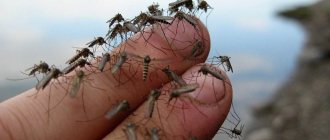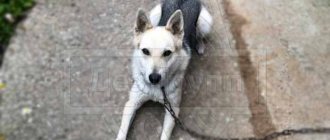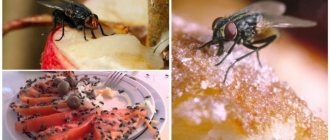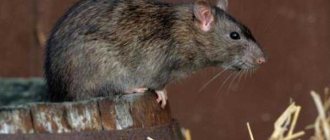- Wild animals
- >>
- Insects
We are surrounded by many interesting insects, among which the hornet .
These creatures have a very bright appearance, are quite large in size, and are excellent hunters of small pests. People don't hold hornets in high esteem. This is not surprising, because they can sting painfully, and their poison in large quantities can even lead to death. However, animals pose a great danger only in exceptional cases; a lethal dose can only be obtained with multiple bites. Otherwise, the hornet is a very interesting, useful insect. It's worth learning more about him!
Origin of the species and description
Photo: Hornet
A large wasp whose flight is accompanied by a loud buzzing sound is a hornet. It is a prominent representative of the family of social wasps, often called the hornet wasp. In Latin, the name of the species sounds like “Vespa”. It is translated into Russian by the word “wasp”. Initially, all social wasps were classified in the genus Vespa. However, in the nineteenth century it was divided into two families. Hornets are still Vespa and wasps are still Vespula (little wasp).
Video: Hornet
The origin of the Russian name “hornet” is no less interesting. The root of this word, in turn, means head, horns. For this reason, scientists concluded that the hornet wasp received its name due to the anatomical features of the structure of the head. The animal has an enlarged crown and movable antennae.
To date, about twenty species of hornet wasps have been recorded. Vespa mandarinia is recognized as the largest species. Adult Vespa mandarinia can reach five and a half centimeters in length.
Among the various types of hornets, we can separately highlight the most interesting of them:
- black hornet. This is a little-known, rare species of social wasp. Listed in the Red Book due to rapid decline in population numbers. It has the characteristic color of a predator - yellow stripes on a black back;
- Asiatic. Quite a large species with a large wingspan. Lives in Asian territory. It carries a certain danger for humans. Its bite is highly toxic;
- Philippine. It is distinguished by its solid black color and produces dangerous poison. Lives exclusively in the Philippine Islands;
- Oriental. Of all the representatives of the genus, it has the brightest colors. Its belly is decorated with a wide yellow stripe, its body and wings are painted bright red. The species tolerates heat remarkably well and lives in steppes and even deserts.
Does it bite or sting?
The hornet is characterized by powerful jaws. Their bite is deep enough - the wound can heal within a week. When attacking, they use a sting with poison, leaving dots on the body. But in some cases they may simply bite. The poison is dangerous due to toxicity, there is a risk of poisoning the body.
The bites are painful, and the consequences can be completely unpredictable. A particular danger is inherent in the elderly, children, and especially allergy sufferers. Swelling and inflammation of the soft tissues begins immediately after the attack, and then the wound can fester. In case of poisoning, a person will feel nausea and severe dizziness.
Bites are most dangerous for sensitive people who are prone to allergic reactions. A person may feel a deterioration in their condition either after a few hours or after 2-3 days. The danger can be explained by the fact that allergy sufferers struggle well with the effects of the poison.
The result is great swelling and difficulty breathing. Some cases are accompanied by loss of consciousness. The composition of the poison includes histamine, which is the reason why a person feels unwell and there is a risk of anaphylactic shock. Death is possible if medical care is neglected and first aid is not provided in a timely manner.
Appearance and features
Photo: Hornet insect
The average size of these insects is from 1.8 to 3.5 centimeters. Only some species can reach a length of five and a half centimeters. Hornets are different from other members of their family. They have larger dimensions, increased head sizes, and a wide crown. These insects have compound and simple eyes. The color of the head depends on the type of hornet. It can be orange, red with a brown tint, black, yellow.
Adult individuals are distinguished by rather large, strong mandibles. They are colored yellow, brown or black. The insect's head has brown-black antennae. Their number depends on gender. The abdomen of such a wasp is round, with a clearly defined waist. There is a sting at the end of the belly. The sting, if the hornet is calm, is almost invisible. It is pulled into the body. At the beginning of the sting there is a special reservoir. It contains poison.
Hornet wasps have the ability to sting repeatedly. Their sting is smooth and straight. It does not have serrations, unlike the bee one. For this reason, when stung, the animal does not harm itself.
The body color of this type of wasp is similar to others - in most hornets it is black and yellow. The only difference is that the stripes alternate less clearly. However, there are varieties whose color is completely different from their relatives. For example, the variable hornet has a body with black and brown stripes.
Some hornet wasps have a fairly wide yellow or white stripe on their belly. The entire body is covered with small hairs. They grow chaotically and have different sizes. Hornets have three pairs of legs. They are either brown or yellow.
Difference from wasp
Hornet and wasp.
Large dimensions and an enlarged nape distinguish this species. They also have a different color. The back, belly, and antennae of hornets are brown, while that of the wasp is black. Otherwise, they have an identical body structure, thin waist, sting, strong jaw.
The personalities of insects also differ. Large hornets are not as aggressive as wasps. They begin to attack when approaching their nest. The impressive size and menacing buzzing cause great fear in people.
Where does the hornet live?
Photo: Asian hornet
Representatives of this genus are widespread in the Northern Hemisphere. Their habitat depends entirely on the characteristics of the species. So, the most popular is the common hornet. This is the only species that lives in large numbers in Ukraine, Russia, and North America. In Russia, this wasp is represented more in the European part of the territory. You won't find it in the far north. The common hornet also lives in Japan, Korea, and China. Small populations of the animal can be found in Mongolia and Kazakhstan.
North America is not the natural habitat of the common hornet. The insect was brought there quite by accident back in the nineteenth century.
The Asian hornet lives in most of the territory of Asia, in the Jewish Autonomous Region, in the Primorsky and Khabarovsk Territories. It is large in size; in Japan this insect is called the “sparrow bee”. Also in tropical Asia, as in France and Spain, Asian predatory wasps are common. They build their “houses” on tree branches, feed and hunt bees.
The eastern hornet wasp chooses semi-dry subtropical areas for living. It can be found in Uzbekistan, Afghanistan, Turkey, Italy, Romania, Greece, North Africa, and other European and Asian regions. On the vast territory of the Russian Federation, scientists have noticed eight species of hornets. The common oriental hornet lives in the European part of the country. The other six species of insects live in the south of the Far East.
Danger to humans
Danger may present itself to a person under certain developments. To protect themselves, hornets release a special pheromone that signals an alarm. Other residents of the colony quickly react to him and fly to his aid, attacking the victim en masse. Because of this, it is worth eliminating the desire to approach or touch the nest of the wasp family.
If we talk about the mortality rate, it is very small, but there are still risks. In addition, it must be said that with each subsequent sting, it will be more difficult for the body, since the immune system will not cope with the poison, the negative reaction will only intensify.
The bite of this type of insect is much more painful when compared with a bee or wasp. But, of course, everything depends on the individual abilities of the body. In the event of an attack, first aid must be provided to the person as quickly as possible.
It is worth saying that they do not leave their sting in the skin of people, which is why they can sting several times. If we talk about toxicity, then Asian individuals are more dangerous than European ones - the bite is accompanied by sharp pain and severe swelling. There is a risk of hemorrhage and suppuration of the wound.
What does a hornet eat?
Photo: Hornet in flight
The hornet is an amazing creature. It is capable of feeding on both plant and animal matter. In most varieties of such wasps, the diet consists of products familiar to the family: nectar, plant foods with a high sugar content. They are often spotted on rotting fruit, near honey, and on trees with sap flowing from the bark. Hornets constantly fly into orchards. There they feast on sweet overripe fruits. It is at this moment that the animal can sting a person who is reaching for the fruit.
Despite the fact that sweet nectar, fruits, and plant foods can completely satisfy the needs of the hornets’ body, these insects can instantly turn into excellent hunters. They kill other small insects with the help of powerful jaws and stings. Their victims include locusts, other types of wasps, bees, grasshoppers, butterflies, and spiders. Predatory varieties of hornets are capable of destroying about five hundred colonies of bees and wasps in their lifetime.
The most surprising fact is that the hornets themselves rarely consume killed insects for their own food. The animal thoroughly chews its prey until it becomes a uniform suspension. Adults bring this suspension to the nests and give it to the voracious larvae. Considering that the larvae eat small pests, the hornet can be called a beneficial insect.
Nutrition
Hornets love to eat rotten wood. But their favorite food is berries that rot. They prefer foods that contain large amounts of sugar. They can also eat other insects - wasps, bees, grasshoppers. They use poison to kill them, after which they chew them with their powerful jaws.
Hornets can attack an apiary, destroying an entire bee colony - they are attracted by the smell of honey bees. Some of the species search for dead pests, and sometimes they can feast on food waste - meat products, fish.
Features of character and lifestyle
Photo: Hornet Red Book
Hornet wasps lead a social lifestyle. They gather in flocks and build nests. The number of one flock can reach hundreds of individuals. Hornet nests are distinguished by their special elegance and grace. These insects are one of the best builders. The founder of the nest is always the female that has survived the winter. With the onset of warmth, the female begins to search for a suitable place. Usually this place becomes an abandoned hollow in a tree, the attic of a residential building, or a crack in the rock.
The female begins building a nest from rotting wood and old bark. In this nest she establishes her colony. The first offspring of the female become worker wasps. They take over all responsibilities for construction, protecting the house, and feeding the offspring. Working hornets spend the whole day searching for food: nectar, plants, small insects. The lifestyle of hornets is predominantly diurnal.
These insects have a fairly high level of development. All representatives of the genus are able to distinguish each other's status. They do this by smell and other characteristics of adults.
The character of hornets is not warlike, they are not annoying. They will not climb into a jar of jam, and will not bother you with their presence near a feast with sweets and fruits. Hornets prefer to avoid the company of people, although they often build their nests in the attics of residential buildings. Despite this, hornet attacks on people are not that rare. And such a bite may not always go unnoticed. Severe allergic reactions occur. This is due to the high proportion of histamine in the venom of these insects.
Creating a Nest
Hornet's nest.
To create a nest, hornets choose a secluded place that is protected from drafts. Insects are excellent architects. They are able to create unique homes.
Birch or ash wood is used in construction. It is moistened with saliva. The surface of the nest is similar to cardboard or corrugated paper. The structure expands downward. There are about 500 cells in a honeycomb. The color of the cocoon is influenced by the wood. Most often it has a brown color.
Social structure and reproduction
Photo: Hornet
Hornet wasps are quite prolific insects. However, not all females are fertile. Uteruses are capable of reproducing offspring. They are usually large in size. It is the females who become the founders of the hornet family; they begin the construction of the house (nest). Before laying eggs, the queen, with the onset of the first heat, searches for a safe, convenient place to build a house. She lays eggs after building the first few hundred.
Further, her responsibilities include searching for food and caring for future offspring. It takes some time for the eggs to mature. First, larvae emerge from them, then adults. When new members of the community become like adult hornets, they take over all the responsibilities of their parent. The queen continues to lay eggs, and the worker wasps get food, guard the house, complete its construction, and care for the larvae.
After four weeks, new hornets emerge from the larvae. They usually kill the queen due to her inability to reproduce any more. Some individuals simply kick her out of the nest. Representatives of the genus living in the European part do not live long. Their total lifespan is only a few months. Only queens have a long life expectancy. They are able to spend the winter in suspended animation.
Hornets can give a good rebuff to their enemy as a whole flock. To protect themselves, they know how to quickly mobilize forces. In case of danger, this animal releases an alarm pheromone. If such a signal is noticed by his relatives, then the attacker faces real danger.
Lifespan
Hornets differ not only in their external features, but also in their functionality and their tasks. In the autumn, the male begins fertilization, after which he dies after a short period of time. Working individuals also do not live long - their lifespan is no more than 3 weeks. The maximum duration for a female is about a year.
Workers and males grow at the end of summer, and in the autumn they already die. If they survive, they can only survive until the first frost.
Males are needed only to perform the fertilization function. At the end of mating, they have only a couple of days to live. Females can tolerate cold and hibernate for a whole year. By the second winter, the queen's life cycle ends and she dies.
Natural enemies of hornets
Photo: Hornet insect
Hornets don't have many natural enemies. This is due to the fact that these insects are relatively peaceful. They prefer to run away from the enemy. Only by defending itself can a hornet show itself as a real hunter. Such animals are especially ferocious if someone has coveted their nest, offspring, or uterus. Also, the small number of natural enemies is explained by the toxicity of hornet wasps, as evidenced by their bright color. Other animals try to avoid such insects.
Some of the natural enemies of hornets include:
- small parasites. Nematodes, parasites, and mites slowly but surely kill large hornets and greatly undermine their health;
- some types of birds. Only certain species of birds are able to hunt representatives of social wasps. Most birds simply swallow them whole, preventing the insect from stinging them;
- fungi. The fungus can grow in the hornet's head, leading to a painful and long death;
- other insects. Hornets can be killed by larger wasps and ants. Ants most often feast on insect larvae;
- of people. Despite the benefits they bring, hornets are considered pests. They settle in residential buildings, are quite dangerous to human health and life, and cause significant damage to young trees. For this reason, hornet nests are often destroyed by people.
Habitats
Hornets live in colonies in nests built in the form of several horizontal tiers of honeycombs. As a material for their home, they use a cardboard-like mass, which they make themselves by chewing wood fibers and moistening it with saliva. A nest can contain up to 7 rows of honeycombs, each row containing about 550 cells.
Hornets make their nests in hollow trees, in old birdhouses, under the roofs of houses, and in attics.
Inhabitants of steppe regions settle in animal burrows or underground.
Population and species status
Photo: Hornet animal
The genus of hornets is quite wide. It includes more than twenty different species of insects, differing in color, size, feeding habits and lifestyle. Due to the presence of several species and high fertility, this genus is not endangered and is not listed in the Red Book.
The general population of hornets does not cause concern among scientists. It is normal, causes the least concern, and has a low risk of extinction. However, if we consider the hornet wasp population in terms of individual species, the situation is not so encouraging. Many species are on the verge of extinction and are listed in the Red Books of individual states and cities. The reduction in the number of such animals is due to completely different reasons, which can be found out in the next section of the publication.
The common hornet is an endangered species. Its population in different regions of its natural habitat is very unstable. In particular, this variety is included in the Red Book of the Smolensk region. Also a small representative of the hornet genus is the Dybovsky hornet (black). It is of average size for hornets, has a black-brown color, and is a predator. The black hornet is included in the Red Book of the Chita region. Some species of hornets are included in the Red Books of Germany and many other European countries.
What to do if bitten
Usually a person does not know well what to do if an insect bites them, or they are not sufficiently aware of first aid recommendations. Severe pain is not the main sign of destruction of the body. It should be noted that the poison contains components that actively affect nerve endings, because of this the appearance of painful shock can be pronounced.
It is very difficult to predict how the body will react, since all reactions are individual. Some may get by with only pain and swelling, while others may experience asphyxia, loss of consciousness, and even death.
It is impossible to remain inactive in such situations; first aid is required:
- The first thing to remember: there will be no sting in the wound, only poison;
- Try to remove the poison from the wound by suction;
- Treat the affected area with a solution based on citric/acetic acid;
- Try washing the wound with soapy water;
- Treat the affected area with a solution that contains sleep, you can also use hydrogen peroxide;
- Next, you need to apply something cold and wet sugar - this will reduce the risk of the poison spreading throughout the body;
- It is forbidden to drink alcohol after bites - such drinks cause swelling and worsening of the victim’s condition;
- As folk remedies, you can use dandelion juice, plantain juice, and soda solution; Onion and garlic cloves also have a good effect on the wound.
Signs of an allergic reaction include:
- Severe headache;
- Increased temperature;
- Increased heart rate;
- Hard breath;
- Abdominal pain.
If you have the above symptoms, first of all you need to take a painkiller tablet. This in turn will reduce the effects of histamine. It is also very important to drink as much fluid as possible to reduce poisoning.
Remember that if the victim’s condition does not improve after first aid, you should urgently call a doctor.
Life cycle
To begin with, it should be noted that bushen are divided into working individuals and females. Just like bees, the first ones live for about 3 weeks. Females live for about a year.
July and August are the times when the colony reaches its peak number of individuals. Then the queen of the swarm ends her life and cedes the fields to the younger generation. In addition to young females capable of reproduction, the first males then appear, which reach sizes close to queens. They can be easily recognized by their longer and thicker probes.
Males do not have a stinger. They have another goal - to make a mating flight with a female. Copulation lasts very short, no more than a few minutes, during which individual females can connect with several males. After fertilization, females look for places for wintering: detached bark, hollow, attic.
After the drones fertilize the females, they die. Those who survive in the fall die during the first cold snap. Females survive the entire winter. When the cold season ends, females begin to build new nests. After the end of the life cycle, females die.
Video
And finally, we bring to your attention a film about our heroes, under the menacing title “Hornets - an empire of ruthless killers.”
Author: Pavel Chaika, editor-in-chief of Poznavaika magazine
When writing the article, I tried to make it as interesting, useful and high-quality as possible. I would be grateful for any feedback and constructive criticism in the form of comments on the article. You can also write your wish/question/suggestion to my email [email protected] or Facebook, with respect, the author.
Author page
The origin of the name “hornet”
Why is the hornet called that?
It is known that the roots of the word “hornet” come from the Latin phrase “vespa crabro”, which literally translates as hornet wasp. Common hornet
is a subspecies of a large wasp that lives throughout Europe. There are also Asian hornets, which are larger in size than ordinary ones.
People call hornets by different names: “flying corsairs”, “pirates” and so on.
In the 19th century, biologists divided one genus of hornets, Vespa, into two different genera - vespula, which includes only wasps, and vespa, which only includes hornets.











